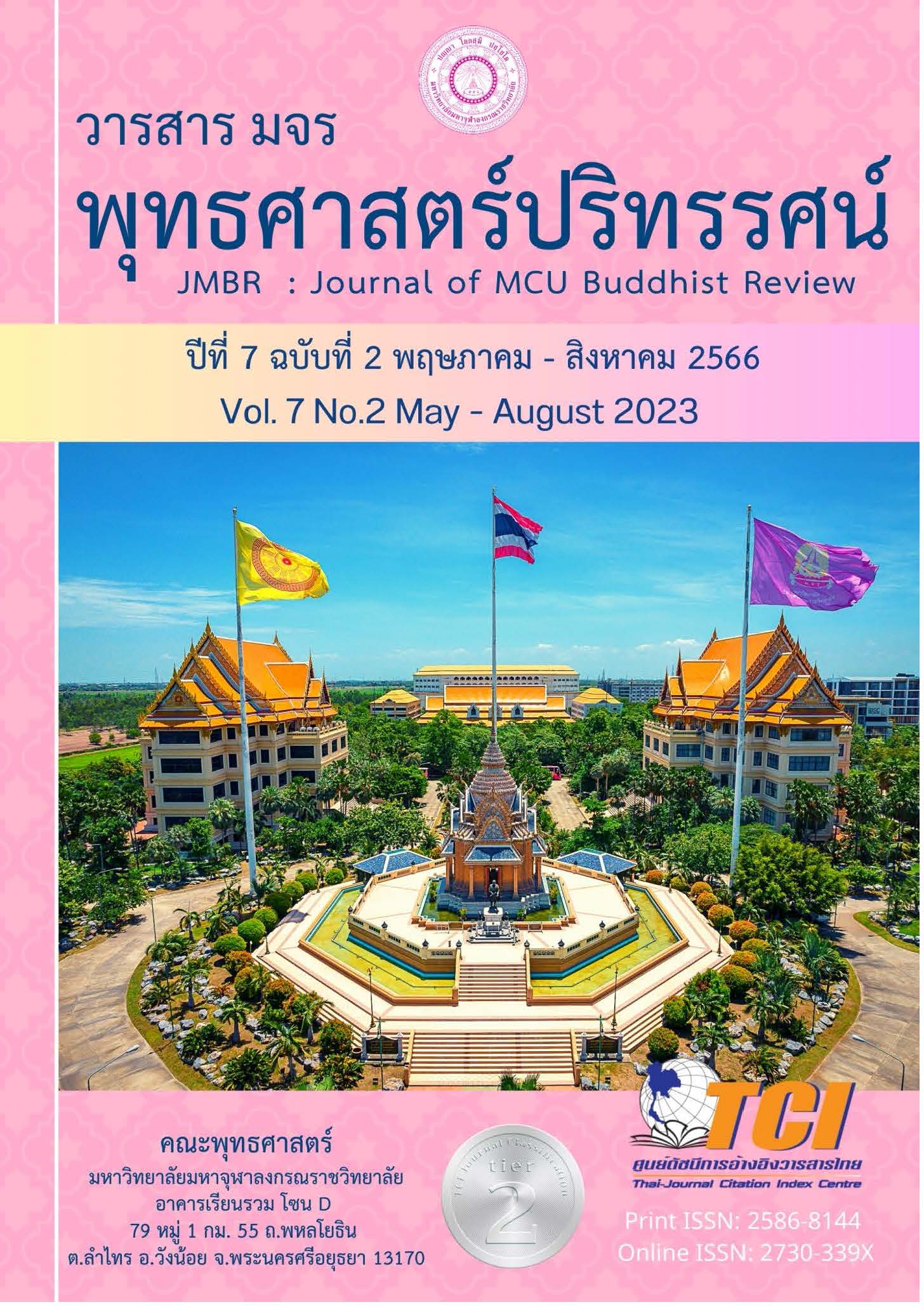ศึกษาวิเคราะห์การสำรวมอายตนะในฉฉักกสูตร
Main Article Content
บทคัดย่อ
บทความนี้มีวัตถุประสงค์ 1) เพื่อศึกษาโครงสร้างและสาระสำคัญของฉฉักกสูตร 2) เพื่อศึกษาการสำรวมอายตนะในพระไตรปิฎก 3) เพื่อวิเคราะห์การสำรวมอายตนะในฉฉักกสูตร การวิจัยครั้งนี้เป็นการวิจัยเชิงคุณภาพโดยการศึกษา รวบรวม และวิเคราะห์ข้อมูลจากเอกสารตามหลักพุทธปรัชญา เขียนบรรยายนำเสนอเชิงพรรณนา
ผลการวิจัยพบว่า 1) ในฉฉักกสูตร พระพุทธเจ้าทรงแสดงธรรมที่มีความเชื่อมโยงกัน ได้แก่ อายตนะภายใน อายตนะภายนอก วิญญาณ สัมผัส เวทนา ตันหา เพื่อแสดงการเกิดแห่งทุกข์ เพราะอาศัยอายตนะภายในและภายนอกกระทบกัน ทางตา หู จมูก ลิ้น กาย ใจ ทำให้เป็นจุดเริ่มของทุกข์ 2) การสำรวมอายตนะในพระไตรปิฎก เป็นการปฏิบัติวิปัสสนากัมมัฏฐานเพื่อฝึกอบรมตนเองใน 3 ด้าน คือ อธิศีลสิกขาคือ ฝึกฝนให้มีศีลยิ่งๆ ขึ้นไป อธิจิตตสิกขาคือฝึกในเรื่องจิตให้ยิ่งๆ ขึ้นไป และ อธิปัญญาสิกขา คือการฝึกฝนให้มีปัญญายิ่งๆ ขึ้นไป เมื่อรับรู้อารมณ์ทางอายตนะทั้ง 6 ต้องมีความสำรวมทางตา หู จมูก ลิ้น กาย ใจ เพื่อควบคุมผัสสายตนะ หากไม่สำรวมอายตนะแล้ว จะเป็นเหตุให้อกุศลธรรมอันลามก คือ อภิชฌา และโทมนัสครอบงำ 3) หลักการสำรวมอายตนะนั้นมุ่งการระมัดระวังใจตนเอง ไม่ให้ยินดียินร้ายในอารมณ์ที่มาปรากฏ ทางตา หู จมูก ลิ้น กาย และใจ เป็นแนวทางในการปฏิบัติวิปัสสนากัมมัฏฐาน อบรมปัญญาให้เกิดความรู้เท่าทันสิ่งที่เกิดขึ้น เข้าใจสิ่งทั้งหลายตามความเป็นจริง จากผลการศึกษาวิจัยนี้ สามารถนำหลักการสำรวมอายตนะไปประยุกต์ใช้ในการดำเนินชีวิตประจำวันด้วยการมุ่งระมัดระวังใจตนเอง ไม่ให้หลงไปยินดียินร้ายในอารมณ์ที่มาปรากฏ ทางตา หู จมูก ลิ้น กาย และใจ มีสติรูเท่าทันการกระทบที่เกิดขึ้นทางอายตนะตลอดเวลา ช่วยบรรเทากิเลสไม่ให้ครอบงำจิตใจ
Article Details

อนุญาตภายใต้เงื่อนไข Creative Commons Attribution-NonCommercial-NoDerivatives 4.0 International License.
- บทความที่ได้รับการตีพิมพ์เป็นลิขสิทธิ์ของวารสาร มจร พุทธศาสตร์ปริทรรศน์
- ข้อความใดๆ ที่ปรากฎในบทความที่ได้รับการตีพิมพ์ในวารสาร ถือเป็นความรับผิดชอบของผู้เขียนบทความ และข้อคิดเห็นนั้นไม่ถือว่าเป็นทัศนะและความรับผิดชอบของกองบรรณาธิการวารสาร มจร พุทธศาสตร์ปริทรรศน์
เอกสารอ้างอิง
พระธรรมธีรราชมหามุนี (โชดก ญาณสิทฺธิ). (2546). หลักปฏิบัติสมถะและวิปัสสนากรรมฐาน. พิมพ์ครั้งที่ 6. กรุงเทพฯ: สหธรรมมิก จำกัด.
พระธีรนพ ญาณวีโร (สมัครแก้ว). (2555). การศึกษาวิเคราะห์อายตนะ 12 อันเป็นภูมิวิปัสสนา เฉพาะกรณีการปฏิบัติวิปัสสนาภาวนา 7 เดือน. วิทยานิพนธ์พุทธศาสตรมหาบัณฑิต บัณฑิตวิทยาลัย: มหาวิทยาลัยมหาจุฬาลงกรณราชวิทยาลัย.
พระพรหมคุณาภรณ์ (ป.อ.ปยุตฺโต). (2555). พุทธธรรม ฉบับปรับขยาย. พิมพ์ครั้งที่ 35. กรุงเทพฯ: ผลิธัมม์.
พระสุพจน์ ธมฺมวฑฺฒโน (อยู่เจริญ). (2562). อายตนะกับการบรรลุธรรมในพระพทธศาสนา. วารสาร มจร ปรัชญาปริทรรศน์. 2(2), 51-63.
พระโสภณมหาเถระ (มหาสีสยาดอ). (2548). วิปัสสนานัย เล่ม 1. แปลและเรียบเรียงโดย พระคันธสาราภิวงศ์. ตรวจชำระโดย พระพรหมโมลี (สมศักดิ์ อุปสโม). นครปฐม: ห้างหุ้นส่วนจำกัด ซีเอไอเซ็นเตอร์.
พุทธทาสภิกขุ. (2556). ปฏิจจสมุปบาทจากพระโอษฐ์. พิมพ์ครั้งที่ 8. กรุงเทพฯ: ธรรมสภา.
มหาจุฬาลงกรณราชวิทยาลัย. (2539). พระไตรปิฎกภาษาไทย ฉบับมหาจุฬาลงกรณราชวิทยาลัย. กรุงเทพฯ: จุฬาลงกรณราชวิทยาลัย.
จำลอง ดิษยวณิช. (2549). วิปัสสนากรรมฐานและเชาวน์อารมณ์. เชียงใหม่: แสงศิลป์.
สมเด็จพระญาณสังวร สมเด็จพระสังฆราช สกลมหาสังฆปริณายก. (2553). ความเข้าใจเรื่องปฏิจจสมุปบาท. พิมพ์ครั้งที่ 3. นครปฐม: มหามกุฎราชวิทยาลัย,
สมเด็จพระพุทธโฆษาจารย์ (ป.อ.ปยุตฺโต). (2561). พจนานุกรมพุทธศาสน์ ฉบับประมวลศัพท์. พิมพ์ครั้งที่ 31. กรุงเทพฯ: ผลิธัมม์ จำกัด.
สุภีร์ ทุมทอง. (2555). การพัฒนาอินทรียสังวร. พิมพ์ครั้งที่ 2. กรุงเทพฯ: บริษัทศิริวัฒนาอินเตอร์ พริ้นท์ จำกัด มหาชน.
อุทัย บุญเย็น. (2545). พระไตรปิฏกสำหรับผู้เริ่มศึกษา. กรุงเทพฯ: โพธิเนตร จำกัด.


